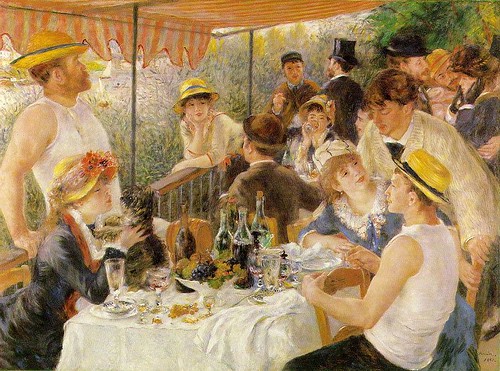Hemingway's story is filled with an underlying tension. He excludes the word "abortion" from the story creating the feeling of fear and ignorance. The way Hemingway writes this story seems to be more like a script for a short film than a short story. Short conversational dialogue dominates the piece. Also the scenery description is very sparse, practically to the point with no “fluff” description (the kind one would find in Romantic writing e.g. The Scarlet Letter.)
Although the language is colloquial there is some great meaning behind the simple words. The couple just jumps right into their meeting as if they’d had similar meetings before. Before any sort of greeting the girl is already there waiting for the man with the question that seems to distinguish each meeting, “What should we drink?” Hemmingway employs repetition of the word white. This could indicate his want to show the girl’s desire for purity. The white elephants/hills are also comparable to a pregnant belly. There is also impatience and a disconnection between the characters. The man snaps at the girl when she says that he wouldn’t have seen an elephant. Perhaps she is Hispanic (the story takes place in
 http://farm4.static.flickr.com/3625/3693419306_874f936c00.jpg
http://farm4.static.flickr.com/3625/3693419306_874f936c00.jpg
It’s interesting that Hemingway chooses to call the characters “man” and “girl”, also contrasting the “girl” with the “woman” at the bar. This age discrepancy is important to the nature of their relationship. It seems that the man has been in that situation before; he knows all about the “operation” and how it goes. He insincerely promises to stay by her side. On the other hand she needs him to love her, “'And if I do it you'll be happy and things will be like they were and you'll love me?'” She also says she doesn’t care about herself. The girl is lonely and needs to be needed by the man.
The dialogue often says two things at once.
'And we could have all this,' she said. 'And we could have everything and every day we make it more impossible.' (G) [Everything for the girl means the baby]
'What did you say?' (M)
'I said we could have everything.' (G)
'No, we can't.' (M) [Shows he truly doesn’t want the baby and thinks the girl should have an abortion]
'We can have the whole world.' (G) [The girl is still hopeful about the future. She insists the could have the baby and still maintain their relationship]
'No, we can't.' (M) [Guy says it’s either the baby or him]
'We can go everywhere.' (G) [They won’t have to hide their relationship]
'No, we can't. It isn't ours any more.' (M) [The baby isn’t theirs anymore- because of the abortion- or the decision isn’t theirs. Once again this could be an issue of clashing cultures. Perhaps the girl is afraid of facing the consequences in her community of being with a foreign man- a Romeo and Juliet situation.]
'It's ours.' (G) [The baby is theirs, so is the decision.]
'No, it isn't. And once they take it away, you never get it back.' (M) [Once they kill the baby, it will never come back. Or once they take your pride/reputation away you can never get it back.]
'But they haven't taken it away.' (G) [I still have the baby, I still have some pride]
'We'll wait and see.' (M) [I know you’ll have the abortion. I’ve been through this before.]




















